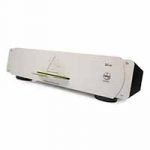ARYLIC S10 WIRELESS STREAMING PREAMPLIFIER
The Arylic S10 is a wireless streamer that is tiny and costs less than £70. Surely for that money it’s going to be crap? Let’s find out.
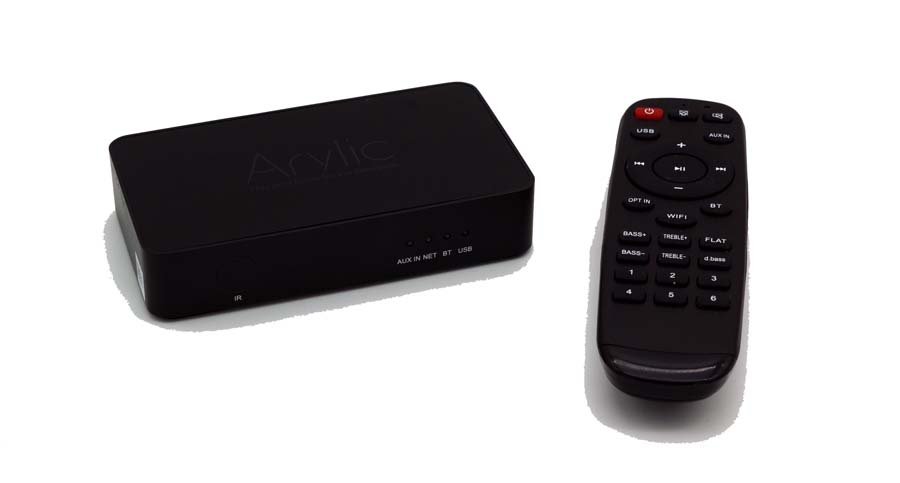
The S10 is a tiny unit and runs from an app, though the included remote is useful too.
The Arylic S10 is a tiny, USB-powered, wired or wireless streamer that does 24bit/192kHz, Airplay, Spotify Connect, QPlay, DLNA, UPnP, Spotify, Deezer, Tidal, Qobuz, etc. etc. It comes with an iOS and Android app and a remote control from which you can play with the EQ. You can pull files from your network or plug in a pen drive as well as being able to stream to it by Bluetooth (Bluetooth 5). You can also stream via the USB input from a PC.
It’s around the size of a thick but small mobile phone and has connections on the back for wireless LAN, USB in, the included 5V USB power and AUX ins and outs. The AUX ins and outs are via 3.5mm sockets but in the box you get a 3.5mm jack to jack and a 3.5mm jack to 2X RCA so you can connect it to an amplifier or preamplifier…or a pair of active speakers like the Acoustic Energy AE1 Actives we have just reviewed.
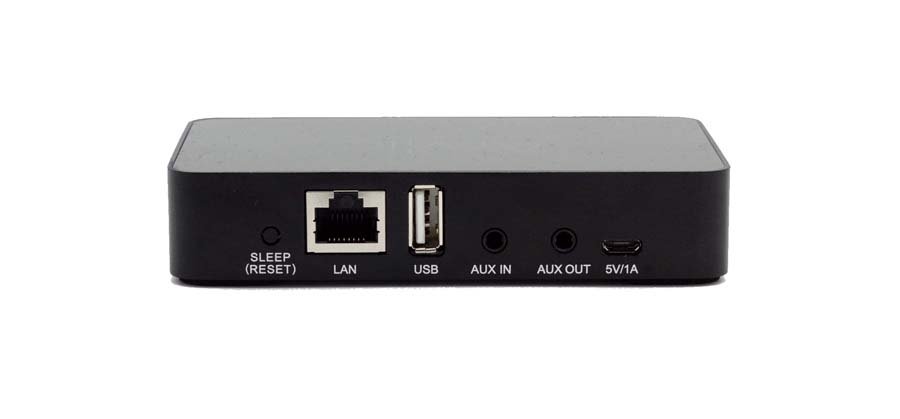
Around the back of the S10 showing the available ins and outs.
Connect several of these to the same network and you have a full multiroom setup.
On the front of the box, you’ve got a little window for the IR remote to be seen and then a series of four LEDs to let you know what source is selected. There’s also a SLEEP/RESET button on the back that functions as an on/off button, WiFi and Bluetooth pairing, and to reset the unit to factory settings.
The cost of all this is €90 and it’s on Amazon UK for less than £65.
The company pushing this little unit for review were pretty pushy with two separate employees contacting me individually asking for a review and I nearly didn’t do this at all, however, a streamer for less than seventy quid has to be a bit of a bargain, doesn’t it? Let’s see.
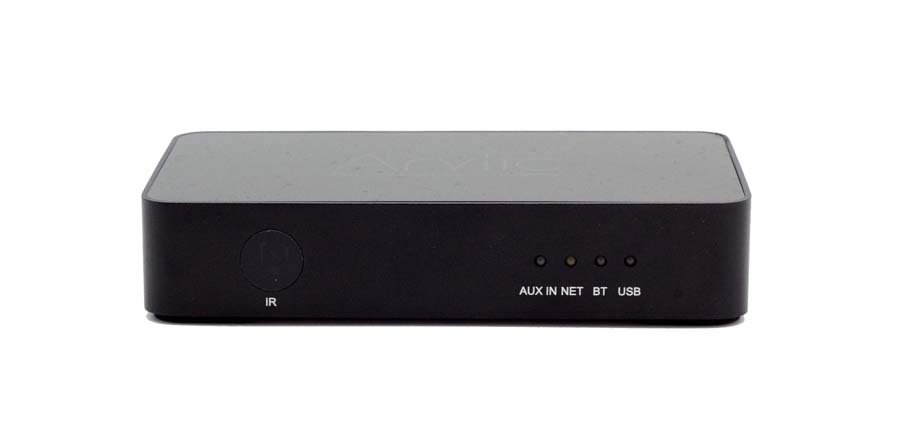
A window for the IR remote and a handful of LEDs to show source and status is all you get.
SET UP
The Arylic uses the 4STREAM app that you can download from the Play or App stores.
The process for set-up is easy. Wire it up to the preamp using the cable provided, hold the power button and plug the unit into the power (bit weird). Open the Stream app making sure you have GPS and Bluetooth switched on (again a bit weird) and then follow the instructions on the app. You’ll need to choose your network and add your password and that’s it. Once sorted the S10 will check for updates and carry this out automatically. You can then choose to change the name of the S10 if you want which will be useful if you have a few of them around the house – I haven’t and so didn’t.
All worked as expected and there were no issues at all.
Connecting to Qobuz was as easy as selecting Qobuz from the app, inputting the username and password, and hey presto we had music.
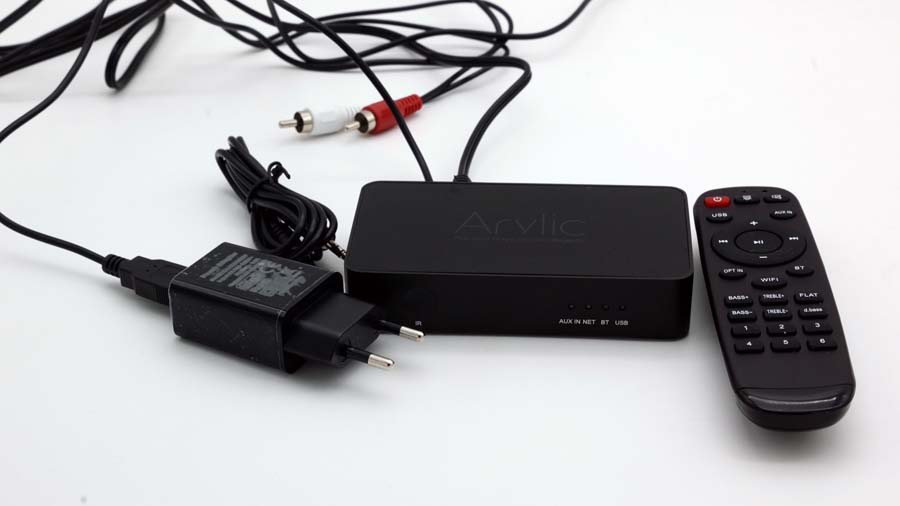
Everything you need to get up and running is in the box.
SOUND QUALITY
In honesty, I was really expecting this to be a bit pants, but as ever I approached it with an open mind and connected it directly into the back of the LAB12 Suara power amp and used the volume control on the app. The little remote can control the volume and other functions too and it works as you’d expect it to.
First of all the sound is very tinny and pretty much unlistenable. However, go to the settings in the app and boost the bass right to the top and it comes together nicely. I’m putting this 70 quid little box into thirty grand-worth of amp and speakers and it should sound pretty shit – it really doesn’t sound at all terrible and I’m not just talking for the money. It’s a little bit harsh at the top end and ragged around the edges if you analyse it closely, but it’s certainly more than listenable. There’s a good degree of soundstage and you can separate things out in the mix pretty well.
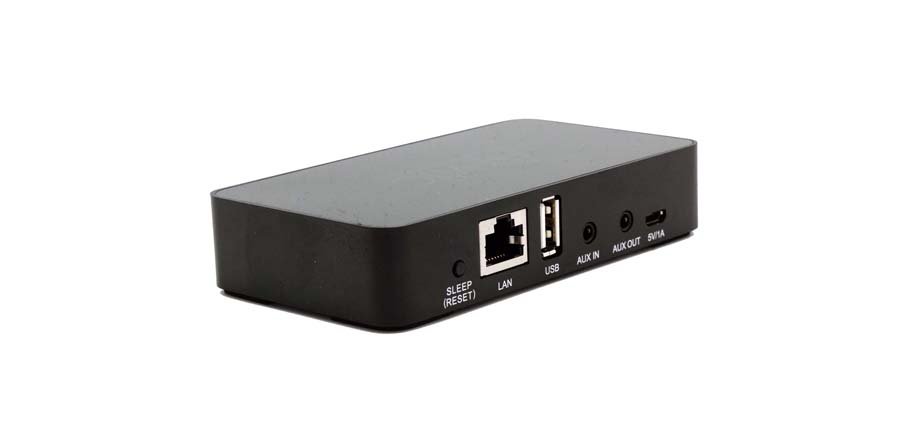
Another shot of the rear of the S10
Switching from Qobuz to files stored on a Synology NAS is all very simple to do on the App with my only complaint being that there’s a bit of a lag loading new pages as you scroll through your tunes. Sonically it’s the same story – a bit sharp and skewed towards a harsh-sounding top end and turning the treble EQ down anything from one notch from the central position has it sounding dull – I found that throughout my listening that the best positioning was bass full-on and treble one notch to the left of centre.
On this system, the treble does get a bit much after long sessions but we are talking about a system that is going to pull out deficiencies pretty mercilessly and it’s been set up for just that reason. Sadly the Acoustic Energy AE1 Actives we recently reviewed were packed away ready for pick up, but I reckon adding one of these to a set of them would make for a very acceptable system for £1100 given you can tune the speakers and the streamer, though you will need a longer minijack to RCA cable than the one provided.
Here’s the bottom line on this little streamer with regards to sound quality; it’s not going to wow you with its sonic attributes but nor is it going to offend you overly if you play with the very basic onboard EQ settings. I wouldn’t choose it as my day to day streamer in our main system as it’s simply outclassed by the other equipment and they highlight it shortcomings, but with something like the Acoustic Energy AE1 Actives (a very good speaker system in its own right) I think you’d be hard pushed to find too much fault in it – with the caveats that I’ve mentioned.
Bluetooth for me is a bit of an academic subject as it rarely works properly on any product and it was the same here for me. Pairing is easy and whatnot but streaming from YouTube I got constant dropouts, as I often do when trying it and so this is more likely an issue with my phone or the house.
CONCLUSION
I try to enter into all our reviews with an open mind, but the truth is I didn’t with this review, and given the pushiness of the folk at Arylic I really didn’t want to like it at all. However, the Arylic is actually not a bad product at all if you go at it without expecting the moon on a stick. In fact, it’s actually a pretty decent product given it costs what it does.
I found the basic EQ helped a fair old bit but Arylic do offer PC users a product called the ACP Workbench Stereo Equalizer that allows a much greater level of sophistication with regards to tweaking the sound for €$20. Personally, I’d have paid the extra few quid to have this onboard and controllable by the app, though I think the processor et needed to sort this would push the price a lot more.
I’ve seen stories online of people having issues with these units making hissing noise but the unit I had didn’t exhibit any of these problems at all. Anyway, if you buy this and it does then just return it for a refund.
Can I recommend the Arylic S10? Yes, I can, but not overly enthusiastically for those looking for an audiophile experience. If you are on a tight budget, looking for a streamer that works well, takes up negligible real estate and you have a system that is relevant (not hugely resolving) then I think the Arylic is a sensible choice.
The award I give this is heavily influenced by the very low cost of the unit but needs to be taken with caveats mentioned in the body of the review.
AT A GLANCE
Build Quality and Features:
It’s tiny and it’s basic but it gets the job done
Mini-jack ins and outs rather than RCAs
Easy to set up and get going
OK remote. I’ve seen worse on far more expensive kit
App works as advertised
Wired or wireless
Bluetooth
Sound Quality:
It’s actually not all bad news
Errs towards being very bright which can become fatiguing. Very basic onboard EQ can mitigate this to an extent, but it’s not a perfect scenario
Value For Money:
I hate to say it but it is good value for money for what it is and my award reflects this
We Loved:
The price
The size
Not awful sounding when tweaked
Has a remote
We Didn’t Love So Much:
Minijack inputs
Crappy cables, but this is par for the course even with more expensive tackle
Harsh sounding without the EQ tweaked and even then it can be tiring on a highly resolving system
Price: €90 but available in the UK at £65. $79
Elevator Pitch Review: The Arylic S10 is a tiny streamer with onboard DAC that costs very little. It works very well and doesn’t sound awful, but can sound quite harsh. Very basic onboard EQ mitigates this somewhat but it is still not great in a very resolving system. However, at the level the S10 is pitched there will be few people that will find cause for complaint. It also offers multi-room capability for those that want to buy several for around their home.

Stuart Smith
Review Equipment: LAB 12 power amp, Audiovector R6 loudspeakers.


















































